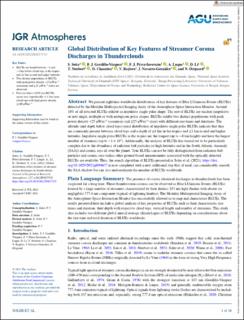| dc.contributor.author | Soler, S. | |
| dc.contributor.author | Gordillo-Vázquez, F.J. | |
| dc.contributor.author | Pérez-Invernón, F.J. | |
| dc.contributor.author | Luque, A. | |
| dc.contributor.author | Li, D. | |
| dc.contributor.author | Neubert, T. | |
| dc.contributor.author | Chanrion, O. | |
| dc.contributor.author | Reglero, V. | |
| dc.contributor.author | Navarro-González, J. | |
| dc.contributor.author | Østgaard, Nikolai | |
| dc.date.accessioned | 2023-04-04T07:52:35Z | |
| dc.date.available | 2023-04-04T07:52:35Z | |
| dc.date.created | 2023-01-13T13:59:28Z | |
| dc.date.issued | 2022 | |
| dc.identifier.issn | 2169-897X | |
| dc.identifier.uri | https://hdl.handle.net/11250/3061966 | |
| dc.description.abstract | We present nighttime worldwide distributions of key features of Blue LUminous Events (BLUEs) detected by the Modular Multispectral Imaging Array of the Atmosphere-Space Interaction Monitor. Around 10% of all detected BLUEs exhibit an impulsive single pulse shape. The rest of BLUEs are unclear (impulsive or not) single, multiple or with ambiguous pulse shapes. BLUEs exhibit two distinct populations with peak power density <25 µWm−2 (common) and ≥25 µWm−2 (rare) with different rise times and durations. The altitude (and depth below cloud tops) zonal distribution of impulsive single pulse BLUEs indicate that they are commonly present between cloud tops and a depth of ≤4 km in the tropics and ≤1 km in mid and higher latitudes. Impulsive single pulse BLUEs in the tropics are the longest (up to ∼4 km height) and have the largest number of streamers (up to ∼3 × 109). Additionally, the analysis of BLUEs has turned out to be particularly complex due to the abundance of radiation belt particles (at high latitudes and in the South Atlantic Anomaly [SAA]) and cosmic rays all over the planet. True BLUEs can not be fully distinguished from radiation belt particles and cosmic rays unless other ground-based measurements associated with the optically detected BLUEs are available. Thus, the search algorithm of BLUEs presented in Soler et al. (2021), https://doi.org/10.1029/2021gl094657 is now completed with a new additional step that, if used, can considerably smooth the SAA shadow but can also underestimate the number of BLUEs worldwide. | en_US |
| dc.language.iso | eng | en_US |
| dc.publisher | AGU | en_US |
| dc.rights | Navngivelse-Ikkekommersiell 4.0 Internasjonal | * |
| dc.rights.uri | http://creativecommons.org/licenses/by-nc/4.0/deed.no | * |
| dc.title | Global Distribution of Key Features of Streamer Corona Discharges in Thunderclouds | en_US |
| dc.type | Journal article | en_US |
| dc.type | Peer reviewed | en_US |
| dc.description.version | publishedVersion | en_US |
| dc.rights.holder | Copyright 2022 The Author(s) | en_US |
| dc.source.articlenumber | e2022JD037535 | en_US |
| cristin.ispublished | true | |
| cristin.fulltext | original | |
| cristin.qualitycode | 2 | |
| dc.identifier.doi | 10.1029/2022JD037535 | |
| dc.identifier.cristin | 2106636 | |
| dc.source.journal | Journal of Geophysical Research (JGR): Atmospheres | en_US |
| dc.identifier.citation | Journal of Geophysical Research (JGR): Atmospheres. 2022, 127 (24), e2022JD037535. | en_US |
| dc.source.volume | 127 | en_US |
| dc.source.issue | 24 | en_US |

